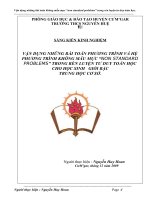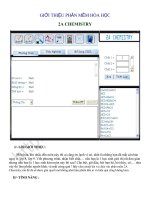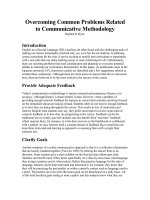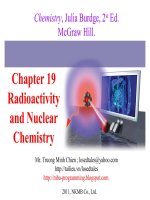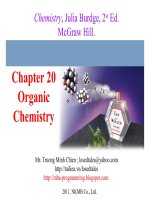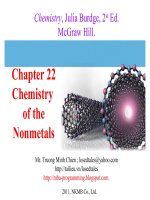- Trang chủ >>
- THPT Quốc Gia >>
- Hóa
Glencoe chemistry supplemental problems 0078245354
Bạn đang xem bản rút gọn của tài liệu. Xem và tải ngay bản đầy đủ của tài liệu tại đây (1.39 MB, 44 trang )
Supplemental
Problems
A Glencoe Program
Hands-On Learning:
Laboratory Manual, SE/TE
Forensics Laboratory Manual, SE/TE
CBL Laboratory Manual, SE/TE
Small-Scale Laboratory Manual, SE/TE
ChemLab and MiniLab Worksheets
Review/Reinforcement:
Study Guide for Content Mastery, SE/TE
Solving Problems: A Chemistry Handbook
Reviewing Chemistry
Guided Reading Audio Program
Applications and Enrichment:
Challenge Problems
Supplemental Problems
Teacher Resources:
Lesson Plans
Block Scheduling Lesson Plans
Spanish Resources
Section Focus Transparencies and Masters
Math Skills Transparencies and Masters
Teaching Transparencies and Masters
Solutions Manual
Technology:
Chemistry Interactive CD-ROM
Vocabulary PuzzleMaker Software,
Windows/MacIntosh
Glencoe Science Web site:
science.glencoe.com
Assessment:
Chapter Assessment
MindJogger Videoquizzes (VHS/DVD)
Computer Test Bank, Windows/MacIntosh
Copyright © 2002 by The McGraw-Hill Companies, Inc.
All rights reserved. Permission is granted to reproduce the material contained herein
on the condition that such material be reproduced only for classroom use; be provided
to students, teachers, and families without charge; and be used solely in conjunction
with the Chemistry: Matter and Change program. Any other reproduction, for use or
sale, is prohibited without prior written permission of the publisher.
Send all inquiries to:
Glencoe/McGraw-Hill
8787 Orion Place
Columbus, OH 43240-4027
ISBN 0-07-824535-4
Printed in the United States of America.
1 2 3 4 5 6 7 8 9 10 045 09 08 07 06 05 04 03 02 01
SUPPLEMENTAL PROBLEMS
Contents
To the Teacher . . . . . . . . . . . . . . . . . . . . . . . . . . . . . . . . . . . . . . . . iv
Chapter 2
Data Analysis . . . . . . . . . . . . . . . . . . . . . . . . . . . . . . . . . . . 1
Chapter 3
Matter—Properties and Changes . . . . . . . . . . . . . . . . . . . . . 3
Chapter 4
The Structure of the Atom . . . . . . . . . . . . . . . . . . . . . . . . . 5
Chapter 5
Electrons in Atoms . . . . . . . . . . . . . . . . . . . . . . . . . . . . . . . 7
Chapter 6
The Periodic Table and Periodic Law . . . . . . . . . . . . . . . . . 9
Chapter 10 Chemical Reactions . . . . . . . . . . . . . . . . . . . . . . . . . . . . . 11
Chapter 11 The Mole . . . . . . . . . . . . . . . . . . . . . . . . . . . . . . . . . . . . . 13
Chapter 12 Stoichiometry . . . . . . . . . . . . . . . . . . . . . . . . . . . . . . . . . . 15
Chapter 13 States of Matter . . . . . . . . . . . . . . . . . . . . . . . . . . . . . . . . 17
Chapter 14 Gases . . . . . . . . . . . . . . . . . . . . . . . . . . . . . . . . . . . . . . . . 19
Chapter 15 Solutions . . . . . . . . . . . . . . . . . . . . . . . . . . . . . . . . . . . . . 21
Chapter 16 Energy and Chemical Change . . . . . . . . . . . . . . . . . . . . . . 23
Chapter 17 Reaction Rates . . . . . . . . . . . . . . . . . . . . . . . . . . . . . . . . . 25
Chapter 18 Chemical Equilibrium . . . . . . . . . . . . . . . . . . . . . . . . . . . . 27
Copyright © Glencoe/McGraw-Hill, a division of the McGraw-Hill Companies, Inc.
Chapter 19 Acids and Bases . . . . . . . . . . . . . . . . . . . . . . . . . . . . . . . . 29
Chapter 20 Redox Reactions . . . . . . . . . . . . . . . . . . . . . . . . . . . . . . . . 31
Chapter 21 Electrochemistry . . . . . . . . . . . . . . . . . . . . . . . . . . . . . . . . 33
Chapter 22 Hydrocarbons . . . . . . . . . . . . . . . . . . . . . . . . . . . . . . . . . . 35
Chapter 24 The Chemistry of Life . . . . . . . . . . . . . . . . . . . . . . . . . . . 37
Chapter 25 Nuclear Chemistry . . . . . . . . . . . . . . . . . . . . . . . . . . . . . . 39
Answer Key . . . . . . . . . . . . . . . . . . . . . . . . . . . . . . . . . . . . . . . . . . . . . 42
Supplemental Problems
Chemistry: Matter and Change
iii
To the Teacher
Copyright © Glencoe/McGraw-Hill, a division of the McGraw-Hill Companies, Inc.
This Supplemental Problems book provides additional problems to
supplement those in the student edition of Chemistry: Matter and Change.
These problems are provided for each of the chapters for which additional
mathematical problems would be beneficial. Most chapters contain 10–25
supplemental problems. You might use them as assessments or assign them
for homework. Complete solutions can be found at the back of the
Supplemental Problems book.
iv
Chemistry: Matter and Change
Supplemental Problems
2
CHAPTER
SUPPLEMENTAL PROBLEMS
Data Analysis
1. A sample of aluminum is placed in a 25-mL
graduated cylinder containing 10.0 mL of
water. The level of water rises to 18.0 mL.
Aluminum has a density of 2.7 g/mL. Calculate
the mass of the sample.
2. Saturn is about 1 429 000 km from the Sun.
How many meters is Saturn from the Sun?
Write your answer in scientific notation.
3. Use the graph to answer the questions.
4. Look at the graph below. Then answer the
questions.
The Composition of Earth’s Crust
Magnesium
2%
Sodium
Potassium
2%
2%
Calcium
4%
Iron
6%
Aluminum
8%
Titanium
1%
Other
elements
1%
Oxygen
46%
Silicon
28%
Radii of Planets
75 000
a. What kind of graph is this?
b. According to the graph, which element is
55 000
0
Earth’s crust is made up of titanium? Of
calcium?
Pluto
Earth
Mars
5000
Venus
15 000
Mercury
25 000
c. According to the graph, what percent of
Neptune
35 000
Uranus
45 000
Saturn
most abundant in Earth’s crust?
Jupiter
Radius (in km)
Copyright © Glencoe/McGraw-Hill, a division of the McGraw-Hill Companies, Inc.
65 000
Planet
a. What kind of graph is this?
5. You place a 28.95-g piece of gold in a 10-mL
graduated cylinder. The level of the water rises
1.50 mL. What is the density of gold? You
know that silver has a density of 10.5 g/cm3.
What mass of silver will raise the level of the
water in the graduated cylinder 1.50 mL?
b. What are the variables?
c. According to the graph, which has a larger
radius, Neptune or Uranus?
6. Convert 55 miles per hour to kilometers per
hour. How many kilometers/second is 55 miles
per hour? (1 mile ϭ 1.6 km)
d. According to the graph, what is the radius
of Saturn?
e. Convert the radius of Saturn to meters.
Write your answer in scientific notation.
7. Convert the following data to scientific
notation.
a. 166 000 000 000 000 m2
b. 8847 m
c. 484 liters
Supplemental Problems
Chemistry: Matter and Change • Chapter 2
1
CHAPTER
2
SUPPLEMENTAL PROBLEMS
8. Convert the following as indicated.
a. Aluminum boils at 2467°C. What is
aluminum’s boiling point in kelvins?
b. Bromine melts at Ϫ7.2°C. What is
bromine’s melting point in kelvins?
c. Chlorine melts at 172 K. What is chlorine’s
melting point in °C?
12. Mac measured the density of silver three times
and obtained the following results:
Trial 1: 10.6 g/cm3; Trial 2: 10.8 g/cm3;
Trial 3: 9.6 g/cm3.
Silver has a density of 10.5 g/cm3
a. Calculate Mac’s percent error for each trial.
b. Which trial had the greatest percent error?
d. What is 273 K in °C?
13. You calculate that your semester average in
9. American cars use about 600 000 000 gallons
of oil per year. How many liters of oil do
American cars use per year? Report your
answer in scientific notation.
(1 L ϭ 0.908 quart; 1 gallon ϭ 4 quarts)
history is 97.5. When you get your report card,
your average is 96. What was the percent error
of your calculation?
14. Determine the number of significant figures in
each measurement.
a. 0.000 301 5 m
Solve the following problems. Express your
answers in proper scientific notation.
b. 0.121 012 L
c. 1.056 mL
d. 12.90 s
b. 3.7 ϫ 106 Ϫ 8.0 ϫ 105 ϭ
e. 5000 dogs
c. 1.85 ϫ 1016 ϩ 9.25 ϫ 1016 ϭ
f. 5.78910 ϫ 103 g
d. 2.8 ϫ 1022 ϩ 82 ϫ 1021 ϭ
e. 3.09 ϫ 1020 Ϫ 9.1 ϫ 1019 ϭ
15. Round the number 31.257 592 to the requested
number of significant figures.
f. 17 ϫ 103 ϩ 3 ϫ 104 ϩ 1.3 ϫ 104 ϭ
a. 7 significant figures
b. 5 significant figures
g. 4.80 ϫ
1015
Ϫ 13 ϫ
11. a. (4.0 ϫ
105)
ϫ (3.0 ϫ
1013
ϭ
c. 3 significant figures
103)
ϭ
b. (5.0 ϫ 1012) ϫ (8.05 ϫ 103) ϭ
16. Complete the following calculations. Round off
c. (8.9 ϫ 105) Ϭ (3.0 ϫ 103) ϭ
the answers to the correct number of significant
figures.
d. (1.6 ϫ 1012) Ϭ (8.01 ϫ 10Ϫ3) ϭ
a. 2.30 m ϫ 3.65 m ϫ 0.55 m ϭ
e. (9.0 ϫ 105) ϫ (3.0 ϫ 10Ϫ3) ϭ
b. 103.8 m Ϭ 31 s ϭ
f. (2.4 ϫ 103) Ϭ (8.0 ϫ 10Ϫ3) ϭ
c. 26.0 cm ϫ 2.1 cm ϭ
g. (6.1 ϫ 10Ϫ5) Ϭ (3.01 ϫ 10Ϫ2) ϭ
2
Chemistry: Matter and Change • Chapter 2
Supplemental Problems
Copyright © Glencoe/McGraw-Hill, a division of the McGraw-Hill Companies, Inc.
10. a. 5.3 ϫ 1012 ϩ 3.0 ϫ 1011 ϭ
CHAPTER
3
SUPPLEMENTAL PROBLEMS
Matter—Properties and Changes
1. An 18-g sample of element A combines com-
pletely with a 4-g sample of element B to form
the compound AB. What is the mass of the
compound formed?
7. During a chemical reaction, 4.032 g of hydro-
gen combined with oxygen to form 36.032 g of
water. How many grams of oxygen reacted?
8. Nitrogen and oxygen combine to form different
2. A substance breaks down into three component
elements when it is heated. The mass of each
component element is listed in the table below.
What was the mass of the substance before it
was heated?
Component
Mass (g)
A
39.10
B
54.94
C
64.00
compounds, as shown below.
Compound
Chemical
Formula
Mass N/1 g O
Nitric oxide
NO
1.76 g
Nitrogen dioxide
NO2
0.88 g
Nitrous oxide
NO4
0.44 g
What is the ratio of the masses of nitrogen in
each of the following?
NO2/NO4 ϭ
Copyright © Glencoe/McGraw-Hill, a division of the McGraw-Hill Companies, Inc.
3. Silver iodide powder has been used as an anti-
septic and as an agent to seed clouds for rain.
Silver iodide is 45.9% silver by mass. If you
separate a 50-g sample of silver iodide into its
elements, silver and iodine, how much silver
would you have?
4. If 5 g of element A combines with 16 g of ele-
ment B to form compound AB, how many
grams of B are needed to form compound AB2?
How many grams of B are needed to form
AB3?
5. During a chemical reaction, 2.445 g of carbon
reacts with 3.257 g of oxygen to form carbon
monoxide gas. How many grams of carbon
monoxide are formed in this reaction?
NO/NO4 ϭ
NO/NO2 ϭ
9. Carbon and oxygen combine to form carbon
monoxide (CO) and carbon dioxide (CO2). The
masses of oxygen that combine with 12 g of
carbon to form these two compounds are 16 g
and 32 g, respectively. What is the ratio of the
masses of oxygen in CO2/CO?
10. Phosphorus and chlorine combine to form two
different compounds. In one compound, 3.88 g
of phosphorus combines with 13.28 g of chlorine. In the other compound, 1.32 g of phosphorus combines with 7.56 g of chlorine. Do
these data support the law of multiple proportions? Show your work.
6. Ibuprofen has the chemical formula C13H18O2.
It is 75.69% carbon, 8.80% hydrogen, and
15.51% oxygen. How many mg of carbon does
a 200-mg tablet of ibuprofen contain?
Supplemental Problems
Chemistry: Matter and Change • Chapter 3
3
CHAPTER
3
SUPPLEMENTAL PROBLEMS
11. Fluorine and xenon combine to form two dif-
ferent compounds. In one compound, 0.853 g
of fluorine combines with 1.472 g of xenon. In
the other compound, 0.624 g of fluorine combines with 2.16 g of xenon. Do these data support the law of multiple proportions? Show
your work.
12. Ferric chloride is 34.4% iron and 65.6% chlo-
rine by mass. A chemist analyzes three compounds that contain iron and chlorine. Her
results are summarized in the data table below.
Which of these compounds is likely to be ferric
chloride? Explain your answer.
Compound
Mass of the
Sample (g)
Mass of
Fe (g)
Mass of
Cl (g)
25
9.3
15.7
II
25
8.6
16.4
III
27
9.3
17.7
NaHCO3. A 168.02-g sample of baking soda
contains 45.98 g of sodium, 2.02 g of hydrogen, 24.02 g of carbon, and 96 g of oxygen.
What is the mass percentage of each element in
baking soda?
14. The chemical formula for chalk is CaCO3.
A100-g sample of chalk contains 40 g of calcium, 12 g of carbon, and 48 g of oxygen.
What is the mass percentage of each element in
chalk? What would be the mass of calcium in
200 g of chalk?
15. A 17-g sample of ammonia, NH3, contains 3 g
of hydrogen. What percentage of ammonia is
hydrogen? How many grams of nitrogen does
the sample contain?
Copyright © Glencoe/McGraw-Hill, a division of the McGraw-Hill Companies, Inc.
I
13. The chemical formula for baking soda is
4
Chemistry: Matter and Change • Chapter 3
Supplemental Problems
CHAPTER
4
SUPPLEMENTAL PROBLEMS
The Structure of the Atom
1. Use the periodic table to complete the
6. How many more neutrons does thorium-230
following table.
Element
have than protons? How many electrons does
thorium-230 have?
Atomic
Number
Protons
Electrons
7. Show that the mass number and the number of
a. Li
b.
c.
87
93
d. Hg
80
e.
81
f.
75
g. B
protons are conserved in the following nuclear
230
4
equation: 234
92U 0 90 Th ϩ 2He.
8. Give the mass number of each isotope.
a. Be with 5 neutrons
b. Ga with 39 neutrons
c. Si with 16 neutrons
2. Give the number of protons, electrons, and
d. Ti with 26 neutrons
neutrons in each of the following atoms.
Copyright © Glencoe/McGraw-Hill, a division of the McGraw-Hill Companies, Inc.
a. 108
47Au
9. Give the atomic number of each isotope.
b. 40
20Ca
a. magnesium-25
c. 23
11Na
b. bromine-79
c. antimony-121
3. Name each isotope, and write it in symbolic
notation.
a. atomic number 26; mass number 56
b. atomic number 29; mass number 64
c. atomic number 17; mass number 37
4. How many protons, electrons, and neutrons are
10. Neon has two isotopes: neon-10 and neon-12.
a. Which isotope has the greater mass?
b. Which has more neutrons?
c. Which has more protons?
d. Which has more electrons?
in each of the following isotopes?
a. uranium-235
b. hydrogen-3
c. silicon-29
5. How many neutrons does europium-151 have?
What is the isotope’s mass number?
Supplemental Problems
11. Use the table below to calculate the atomic
mass of element X. Then use the periodic table
to identify the element. Show all your work.
Isotope
Mass (amu)
Percent Abundance
16X
15.995
99.762
17X
16.999
0.038
18X
17.999
0.20
Chemistry: Matter and Change • Chapter 4
5
CHAPTER
4
SUPPLEMENTAL PROBLEMS
12. Magnesium has three isotopes. Magnesium-24
15. An element has three naturally occurring iso-
has a percent abundance of 78.99%.
Magnesium-26 has a percent abundance of
11.01%. What is the percent abundance of
magnesium-25? Assume that there are no other
magnesium isotopes.
topes. Information about each isotope is summarized below.
13. Calculate the atomic mass of iridium. Iridium
has two isotopes. Iridium-191 has a mass of
191.0 amu and a percent abundance of 37.58%.
Iridium-191 has a mass of 193.0 amu and a
percent abundance of 62.42%. Show all your
work.
Isotope
Mass (amu)
Percent Abundance
Isotope 1
23.985
78.10
Isotope 2
24.946
10.13
Isotope 3
25.983
11.17
a. Find the atomic mass of this element. Show
all your work.
b. Identify the element, using the periodic
table.
14. An element has three naturally occurring
c. Write each isotope in symbolic notation.
isotopes.
Isotope 1 has a mass of 19.992 amu.
Isotope 3 has a mass of 21.991 amu.
The pie graph shows the relative abundance of
each isotope.
Isotope 2
0.27%
Isotope 3
9.22%
mine the ages of objects that were once living,
such as wood, bones, and fossils. While alive,
living things take in all the isotopes of carbon,
including carbon-14. Carbon-14 undergoes
radioactive decay continuously. After an organism dies, the carbon-14 in its body continues to
decay. However, its body no longer takes in
new carbon-14. Thus, by measuring how much
carbon-14 a once-living object contains and
comparing it with the amount of carbon-14 in a
currently living thing, you can determine the
age of the object.
a. In terms of subatomic structure, how does
Isotope 1
90.51%
carbon-14 differ from carbon-12 and
carbon-13?
b. How is carbon-14 like carbon-12 and
carbon-13?
c. Carbon-14 emits a beta particle as it decays.
What atom does carbon-14 decay to?
a. Calculate the atomic mass of the element.
d. Write an equation to represent the decay of
carbon-14.
b. Identify the element, using the periodic
table.
6
Chemistry: Matter and Change • Chapter 4
Supplemental Problems
Copyright © Glencoe/McGraw-Hill, a division of the McGraw-Hill Companies, Inc.
16. The isotope carbon-14 can be used to deter-
Isotope 2 has a mass of 20.994 amu.
CHAPTER
5
SUPPLEMENTAL PROBLEMS
Electrons in Atoms
1. Orange light has a frequency of 4.8 ϫ 1014 sϪ1.
6. List the sequence in which the following
orbitals fill up: 1s, 2s, 3s, 4s, 5s, 6s, 7s, 2p, 3p,
4p, 5p, 6p, 7p, 3d, 4d, 5d, 6d, 4f, 5f.
What is the energy of one quantum of orange
light?
7. Which element has the ground-state electron
2. Which is greater, the energy of one photon
configuration [Kr]5s24d105p4?
of orange light or the energy of one quantum
of radiation having a wavelength of
3.36 ϫ 10Ϫ9m?
8. Which element has the ground-state electron
configuration [Ar]4s23d10?
3. Use the relationships E ϭ h and c ϭ v to
write E in terms of h, c, and .
9. Write electron-dot structures for the following
atoms.
4. A radio station emits radiation at a wavelength
a. [Ne]3s23p3
of 2.90 m. What is the station’s frequency in
megahertz?
b. [Ar]4s23d3
c. potassium
5. Record the frequency of your favorite radio
Copyright © Glencoe/McGraw-Hill, a division of the McGraw-Hill Companies, Inc.
station. What is the wavelength of the radiation
emitted from the station?
10. Complete the following table.
Orbitals
Element
Symbol
1s
2s
2px
2py
2pz
1s22s22p3
a. Nitrogen
b.
Electron
Configuration
F
)(
)(
)(
)(
)
c. Carbon
d.
Supplemental Problems
1s22s1
Chemistry: Matter and Change • Chapter 5
7
CHAPTER
5
SUPPLEMENTAL PROBLEMS
Increasing Energy
11. Complete the orbital diagram for arsenic.
7p
6d
5f
7s
6p
5d
4f
6s
5p
4d
5s
4p
3d
4s
3p
7p
6d
5f
7s
6p
5d
4f
6s
5p
4d
5s
4p
3d
4s
3p
3s
3s
2p
2s
2p
2s
1s
1s
questions.
13. What is the ground-state electron configuration
of each of the following atoms? Use noble-gas
notation.
a. selenium
b. krypton
2eϪ 8eϪ
8eϪ 2eϪ
c. chlorine
14. What is the highest energy level (n) that is
occupied in the following elements?
a. He
a. How many valence electrons does an atom
of this element have?
b. Ca
c. Sn
b. What is the atom’s electron-dot structure?
c. If enough energy was added to remove an
electron, from which energy level would the
electron be removed? Explain your answer.
15. Write the electron configuration for each ele-
ment described below and identify the element.
a. an element that contains 8 electrons
b. an element that contains 14 electrons
8
Chemistry: Matter and Change • Chapter 5
Supplemental Problems
Copyright © Glencoe/McGraw-Hill, a division of the McGraw-Hill Companies, Inc.
12. Use the figure below to answer the following
CHAPTER
6
SUPPLEMENTAL PROBLEMS
The Periodic Table and Periodic Law
For questions 1–5, do not use the periodic table.
For questions 6–9, do not use Figure 6-12, 6-15,
or 6-20.
1. Write the electron configurations for the
elements in periods 2–4 of group 2A.
6. Rank the following atoms in order of
decreasing radii.
2. Determine the group, period, and block of
a. Al, Na, P, S
the elements with the following electron
configurations.
b. Al, Ga, In
a. [He]2s22p4
c. As, Ge, Ga
b. [Xe]6s1
d. Br, Ca, Cl, K
c. [Ar]4s23d104p2
7. Rank the following ions in order of decreasing
radii.
3. Categorize each of the elements in problem 2
as a representative element or a transition
element.
a. BrϪ, ClϪ, FϪ
b. Be2ϩ, Ca2ϩ, Mg2ϩ
c. Ca2ϩ, Ga3ϩ, Kϩ
4. Write the electron configuration of the element
Copyright © Glencoe/McGraw-Hill, a division of the McGraw-Hill Companies, Inc.
fitting each of the following descriptions. Use
noble-gas notations.
a. Group 8A element in the third period
b. Group 4A element in the fourth period
c. Halogen in the second period
d. Group 1A element in the fourth period
5. What are the noble-gas notations of all the ele-
ments with the following valence electron configurations?
8. Rank the following particles in order of
decreasing radii.
a. I, IϪ
b. K, Kϩ
c. Al, Al3ϩ
9. Rank the following atoms in order of decreas-
ing electronegativity.
a. Na, Li, K
a. s2
b. K, Sc, Ca
b. s2p1
c. As, Sn, S
Supplemental Problems
Chemistry: Matter and Change • Chapter 6
9
CHAPTER
10
SUPPLEMENTAL PROBLEMS
Chemical Reactions
Balance the following chemical equations.
1. SnS2(s) ϩ O2(g) 0 SnO2(s) ϩ SO2(g)
2. C2H6(g) ϩ O2(g) 0 CO2(g) ϩ H2O(g)
3. Al(s) ϩ HCl(aq) 0 AlCl3(aq) ϩ H2(g)
4. CoCO3(s) 0 CoO(s) ϩ CO2(g)
Write a balanced equation for each of the following reactions, substituting symbols and formulas
for names. Include the state of each reactant and
product. Then identify the reaction type for each.
If more than one reaction type applies, list all
that apply.
10. When chlorine gas is passed through a potas-
sium bromide solution, bromine forms in a
potassium chloride solution.
11. Magnesium burns in air to form magnesium
oxide.
Predict the products in each of the following
reactions. If no reaction occurs, write NR. You
may use Figure 10-10 for the relative activities of
common metals and halogens.
12. Rb(s) ϩ CaCl2(aq)
13. Pt(s) ϩ MnBr2(aq)
14. F2(g) ϩ NaI(aq)
Copyright © Glencoe/McGraw-Hill, a division of the McGraw-Hill Companies, Inc.
5. When aluminum nitrate and sodium hydroxide
solutions are mixed, solid aluminum hydroxide
forms. The other product is sodium nitrate.
6. When magnesium is heated in the presence of
nitrogen gas, solid magnesium nitride forms.
7. When solid copper(II) oxide and hydrogen
react, metallic copper and water form.
8. Most industrial production of metallic sodium
is accomplished by passing an electric current
through molten sodium chloride. Chlorine gas
also is produced.
15. Zn(s) ϩ AgNO3(aq)
Write a complete ionic equation and a net
ionic equation for each of the following doubledisplacement reactions.
16. Ba(NO3)2(aq) ϩ H2SO4(aq) 0
BaSO4(s) ϩ 2HNO3(aq)
17. FeCl3(aq) ϩ (NH4)3PO4(aq) 0
FePO4(s) ϩ 3NH4Cl(aq)
18. KCl(aq) ϩ AgC2H3O2(aq) 0
AgCl(s) ϩ KC2H3O2(aq)
9. Liquid pentane (C5H12) burns, producing water
vapor and carbon dioxide.
Supplemental Problems
Chemistry: Matter and Change • Chapter 10
11
CHAPTER
11
SUPPLEMENTAL PROBLEMS
The Mole
1. Identify and calculate the number of representa-
tive particles in each of the following quantities.
a. 2.15 moles of gold
b. 0.151 mole of nitrogen oxide
6. Which quantity has the greatest mass?
a. 4.16 ϫ 1023 atoms of radium
b. 1.50 ϫ 1020 atoms of cadmium
c. 1.33 ϫ 1024 atoms of argon
c. 11.5 moles of potassium bromide
7. Calculate the number of moles in each of the
2. Calculate the number of moles of the substance
that contains the following number of representative particles.
a. 8.92 ϫ 1023 atoms of barium
b. 5.50 ϫ 1025 molecules of carbon monoxide
following quantities.
a. atoms of each element in 3.35 moles of
aspirin (C9H8O4)
b. positive and negative ions in 1.75 moles of
calcium fluoride (CaF2)
c. 2.66 ϫ 1022 formula units of potassium
iodide
8. Determine the molar mass of each of the
following compounds.
3. Determine the mass in grams of each of the
following quantities.
Copyright © Glencoe/McGraw-Hill, a division of the McGraw-Hill Companies, Inc.
a. 1.24 moles of beryllium
b. 3.35 moles of calcium
c. 0.155 mole of sulfur
a. formic acid (CH2O2)
b. ammonium dichromate ((NH4)2Cr2O7)
9. What is the mass in grams of each of the
following quantities?
a. 2.53 moles of lead(II) nitrate (Pb(NO3)2)
4. Calculate the number of moles in each of the
b. 4.62 moles of magnesium bromide (MgBr2)
following quantities.
a. 6.35 g lithium
10. Calculate the number of moles in each of the
b. 346 g zinc
following samples.
c. 115 g nickel
a. 3.75 g calcium carbide (CaC2)
b. 245 g aluminum nitrite (Al(NO2)3)
5. How many atoms are in the following samples?
a. 1.24 g cobalt
11. Determine the percent composition of each of
the following compounds.
b. 0.575 g cesium
a. manganese oxide (MnO)
c. 65.6 g silicon
b. propanol (C3H8O)
c. calcium phosphate (Ca3(PO4)2)
Supplemental Problems
Chemistry: Matter and Change • Chapter 11
13
CHAPTER
11
12. Determine the empirical formula for a 100.00-g
sample of a compound having the following
percent composition.
a. 94.07% sulfur and 5.93% hydrogen
b. 80.68% mercury, 12.87% oxygen, and
6.45% sulfur
13. A 48.30-g sample of an aluminum-iodine com-
pound contains 3.20 g of aluminum. What is
the empirical formula for the compound?
SUPPLEMENTAL PROBLEMS
15. Caffeine is a compound found in some natural
coffees and teas and in some colas.
a. Determine the empirical formula for
caffeine, using the following composition
of a 100.00-g sample.
49.47 grams of carbon, 28.85 grams of
nitrogen, 16.48 grams of oxygen, and
5.20 grams of hydrogen
b. If the molar mass of caffeine is
194.19 g/mol, calculate its molecular
formula.
14. A 50.00-g sample of hydrated manganese(II)
Copyright © Glencoe/McGraw-Hill, a division of the McGraw-Hill Companies, Inc.
chloride yields 31.75 g of the anhydrous compound after heating. Determine the chemical
formula and name of the hydrate.
14
Chemistry: Matter and Change • Chapter 11
Supplemental Problems
CHAPTER
12
SUPPLEMENTAL PROBLEMS
Stoichiometry
1. Silicon nitride is used in the manufacturing of
high-temperature thermal insulation for heat
engines and turbines. It is produced by the following reaction.
3Si(s) ϩ 2N2(g) 0 Si3N4(s)
a. Interpret the equation in terms of particles,
moles, and masses.
b. Show that mass is conserved in the reaction.
2. The heat from a welder’s torch is produced by
the burning of acetylene gas. The reaction is
represented by the following balanced chemical
equation.
2C2H2(g) ϩ 5O2(g) 0 4CO2(g) ϩ 2H2O(g)
Calculate the mole ratios from the balanced
equation.
4. To prevent corrosion and make paints adhere
better, some aluminum products are treated
with chromium(III) phosphate before finishing.
Chromium(III) phosphate (CrPO4) is commercially produced by treating chromium metal
with orthophosphoric acid (H3PO4).
a. Balance the following equation for the
reaction.
Cr(s) ϩ
H3PO4(aq) 0
H2(g) ϩ
CrPO4(s)
b. How many moles of chromium metal are
needed to produce 855 g of chromium(III)
phosphate?
c. The reaction of 206 g chromium will
release how many moles of hydrogen gas?
5. Sand (silicon dioxide) and coke (carbon) are
Copyright © Glencoe/McGraw-Hill, a division of the McGraw-Hill Companies, Inc.
3. Limestone (CaCO3) is treated with hydrochlo-
ric acid and water to manufacture calcium chloride hexahydrate. This compound is used to
melt ice and snow on pavements and roads.
The following balanced chemical equation represents the reaction.
CaCO3(s) ϩ 2HCl(aq) ϩ 5H2O(l) 0
CaCl2и6H2O(s) ϩ CO2(g)
a. How many moles of calcium chloride
hexahydrate will be produced from
4.00 mol calcium carbonate?
b. How many moles of hydrogen chloride will
be needed to produce 1.25 mol of the
hydrate?
combined to form silicon carbide (SiC), a compound used in high-strength ceramic materials.
a. Balance the following equation for the
reaction.
SiO2(s) ϩ
SiC(s) ϩ
C(s) 0
CO(g)
b. What mass of silicon carbide will be
produced from the reaction of 352 g silicon
dioxide?
c. If 1.00 g of carbon is reacted, what mass of
carbon monoxide is released?
c. If 8.33 mol water is available for the
reaction, how many moles of carbon
dioxide will be released?
Supplemental Problems
Chemistry: Matter and Change • Chapter 12
15
12
CHAPTER
SUPPLEMENTAL PROBLEMS
6. Two compounds of nitrogen, nitrogen tetroxide
7. One step in the industrial refining of nickel is
(N2O4) and hydrazine (N2H4), are used as
rocket fuels. When the two compounds are
mixed, they ignite spontaneously and produce
nitrogen gas and water.
the decomposition of nickel carbonyl
(Ni(CO)4) into nickel and carbon monoxide. In
a laboratory reaction, 25.0 g nickel carbonyl
yielded 5.34 g nickel.
a. Balance the following equation for the
a. Balance the following equation for the
reaction.
reaction.
N2O4(l) ϩ
N2(g) ϩ
N2H4(l) 0
H2O(g)
b. If 8.00 g nitrogen tetroxide and 4.00 g
hydrazine are mixed, determine the
following quantities.
Ni(CO)4(g) 0
Ni(s) ϩ
CO(g)
b. Determine the theoretical yield of nickel.
c. Determine the percent yield.
1. limiting reactant
2. mass of product (N2)
Copyright © Glencoe/McGraw-Hill, a division of the McGraw-Hill Companies, Inc.
3. mass of excess reactant
16
Chemistry: Matter and Change • Chapter 12
Supplemental Problems
CHAPTER
13
SUPPLEMENTAL PROBLEMS
States of Matter
1. Calculate the ratio of effusion rates of oxygen
(O2) to hydrogen (H2).
2. Methane (CH4) effuses at a rate of 2.45 mol/s.
6. What is the pressure of a mixture of nitrogen
(N2) and oxygen (O2) if the partial pressure of
N2 is 594 mm Hg and the partial pressure of
O2 is 165 mm Hg?
What will be the effusion rate of argon (Ar)
under the same conditions?
7. A sample of air is collected at 101.1 kPa. If the
3. The effusion rate of hydrogen sulfide (H2S)
partial pressure of water vapor in the sample is
2.8 kPa, what is the partial pressure of the dry
air?
is 1.50 mol/s. Another gas under similar
conditions effuses at a rate of 1.25 mol/s.
What is the molar mass of the second gas?
4. The pressure of a gas in a manometer is
12.9 mm Hg. Express this value in each of
the following units.
a. torr
b. atmosphere
8. Suppose that 5-mL containers of helium (He),
neon (Ne), and argon (Ar) are at pressures of
1 atm, 2 atm, and 3 atm, respectively. The He
and Ne are then added to the container of Ar.
a. What is the partial pressure of He in the
container after the three gases are mixed?
b. What is the total pressure in the container
after the three gases are mixed?
Copyright © Glencoe/McGraw-Hill, a division of the McGraw-Hill Companies, Inc.
c. kilopascal
5. The vapor pressure of water is 2.3 kPa at 23°C.
What is the vapor pressure of water at this
temperature expressed in atmospheres?
Supplemental Problems
Chemistry: Matter and Change • Chapter 13
17
CHAPTER
14
SUPPLEMENTAL PROBLEMS
Gases
1. In one city, a balloon with a volume of 6.0 L is
filled with air at 101 kPa pressure. The balloon
in then taken to a second city at a much higher
altitude. At this second city, atmospheric pressure is only 91 kPa. If the temperature is the
same in both places, what will be the new
volume of the balloon?
2. A certain mass of gas in a 2.25-L container
has a pressure of 164 kPa. What will the new
pressure be if the volume of the container is
reduced to 1.50 L and the temperature stays
constant?
7. A 50.0-mL sample of gas is cooled from 119°C
to 80.0°C. If the pressure remains constant,
what is the final volume of the gas?
8. A 10.0-L cylinder of gas is stored at room tem-
perature (20.0°C) and a pressure of 1800 psi. If
the gas is transferred to a 6.0-L cylinder, at
what Celsius temperature would it have to be
stored in order for the pressure to remain at
1800 psi?
9. If the gas pressure in an aerosol can is
148.5 kPa at 23°C, what is the pressure
inside the can if it is heated to 298°C?
3. If 5.80 dm3 of gas is collected at a pressure of
92.0 kPa, what volume will the same gas
occupy at 101.3 kPa if the temperature stays
constant?
Copyright © Glencoe/McGraw-Hill, a division of the McGraw-Hill Companies, Inc.
4. If the volume of an air pump used to inflate
a football decreases from 480 mL to 375 mL,
and the original pressure was 93.5 kPa, what
is the new air pressure in the pump if the
temperature stays constant?
5. Maintaining constant pressure, the volume of a
gas is increased from 18.0 dm3 to 32.0 dm3 by
heating it. If the original temperature was
18.0°C, what is the new temperature in degrees
Celsius?
10. A tank for compressed gas has a maximum safe
pressure limit of 850 kPa. The pressure gauge
reads 425 kPa when the temperature is 28°C.
What is the highest temperature in degrees
Celsius the tank can withstand safely?
11. In a steel container, it was found that the pres-
sure of the gas inside was 160 kPa when the
container had been heated to 98°C. What had
been the pressure of the gas when the temperature had been 50°C the previous day?
12. A steel cylinder is filled with a gas at a temper-
ature of 25.0°C and a pressure of 225.0 kPa.
What will the pressure be if the temperature is
raised to 47°C?
6. A natural gas tank is constructed so that the
pressure remains constant. On a hot day when
the temperature was 33°C, the volume of gas in
the tank was determined to be 3000.0 L. What
would the volume be on a warm day when the
temperature is 11°C?
Supplemental Problems
13. A balloon is filled with gas at a pressure of
102.3 kPa and a temperature of 45.5°C. Its
volume under these conditions is 12.5 L. The
balloon is then taken into a decompression
chamber where the volume is measured as
2.50 L. If the temperature is 36.0°C, what is
the pressure in the chamber?
Chemistry: Matter and Change • Chapter 14
19
CHAPTER
14
14. A weather balloon contains 14.0 L of helium at
a pressure of 95.5 kPa and a temperature of
12.0°C. If this had been stored in a 1.50-L
cylinder at 21.0°C, what must the pressure in
the cylinder have been?
SUPPLEMENTAL PROBLEMS
21. How many grams of gas are present in a
sample that has a molar mass of 44 g/mol
and occupies a 1.8-L container at 108 kPa
and 26.7°C?
22. What is the molar mass of a gas if 142 g of the
15. How many moles of a gas will occupy 2.50 L
at STP?
gas occupies a volume of 45.1 L at 28.4°C and
94.6 kPa?
16. Calculate the volume that 3.60 g H2 gas will
23. Determine the volume of hydrogen gas needed
17. What volume is occupied by 0.580 mol of gas
24. Calculate the volume of chlorine gas at STP
occupy at STP.
at 98.4 kPa and 11°C?
18. When a sample of a gas was placed in a sealed
container with a volume of 3.35 L and heated
to 105°C, the gas vaporized and the resulting
pressure inside the container was 170.0 kPa.
How many moles of the gas was present?
to make 8 L of water vapor.
that is required to completely react with 3.50 g
of silver, using the following equation:
2Ag(s) + Cl2(g) 0 2AgCl(s).
25. Use the reaction shown to calculate the mass of
iron that must be used to obtain 0.500 L of
hydrogen at STP.
3Fe(s) ϩ 4H2O(l) 0 Fe3O4(s) ϩ 4H2(g)
19. An engineer wishes to design a container that
Copyright © Glencoe/McGraw-Hill, a division of the McGraw-Hill Companies, Inc.
will hold 14.0 mol of gas at a pressure no
greater than 550 kPa and a temperature of
48°C. What is the minimum volume the
container can have?
20. What is the molar mass of a sample of gas that
has a density of 2.85g/L at 101 kPa pressure
and 29°C?
20
Chemistry: Matter and Change • Chapter 14
Supplemental Problems
CHAPTER
15
SUPPLEMENTAL PROBLEMS
Solutions
1. The solubility of a gas is 0.34 g/L at STP. What
is its solubility at a pressure of 0.80 atm and
the same temperature?
2. At 25°C and 1.0 atm, 0.25 g of a gas dissolves
in 1.00 L of water. What mass of the gas dissolves in 1.00 L of water at 25°C and 3.0 atm?
8. What is the molarity of a solution that contains
20.45 g of sodium chloride (NaCl) dissolved in
700.0 mL of solution?
9. Calculate the molarity of 0.205 L of a solution
that contains 156.5 g of sucrose (C12H22O11).
10. A 0.600-L sample of a 2.50M solution of potas-
3. 1.56 g of a gas dissolves in 2.00 L of water at a
pressure of 1.75 atm. At what pressure will
2.00 g of the gas dissolve in 2.00 L of water if
the temperature remains constant?
4. What is the percent by mass of 92.3 g of
potassium fluoride (KF) dissolved in 1000.0 g
of water?
5. A 500.0 g-sample of aqueous hydrogen perox-
Copyright © Glencoe/McGraw-Hill, a division of the McGraw-Hill Companies, Inc.
ide (H2O2) contains 31.50% H2O2 by mass.
a. Find the mass of hydrogen peroxide in the
solution.
sium iodide (KI) contains what mass of KI?
11. What mass of ammonium chloride (NH4Cl)
would you use to prepare 85.0 mL of a 1.20M
solution NH4Cl?
12. How would you correctly prepare 125 mL of a
0.30M solution of copper(II) sulfate (CuSO4)
from a 2.00M solution of CuSO4?
13. A 22.0-mL sample of 12M H2SO4 is diluted to
a volume of 1200.0 mL. What is the molarity
of the diluted solution?
b. Find the mass of water in the solution.
14. A mass of 134 g of manganese dibromide
6. If 24.0 mL of methanol (CH3OH) is dissolved
in 48.0 mL of water, determine the percent by
volume of methanol in the solution.
(MnBr2) is dissolved in 225 g of water. What is
the molality of the solution?
15. Calculate the molality of a solution that con-
7. An aqueous solution of methanol is 45.0%
methanol by volume.
a. Find the volume of methanol in a 250.0-mL
sample of the solution.
b. Find the volume of water in this sample of
tains 106 g naphthalene (C10H8) dissolved in
3.15 mol carbon tetrachloride (CCl4).
16. A solution is made by dissolving 425 g of nitric
acid (HNO3) in 535 g of water. Find the mole
fraction of nitric acid in the solution.
the solution.
Supplemental Problems
Chemistry: Matter and Change • Chapter 15
21
